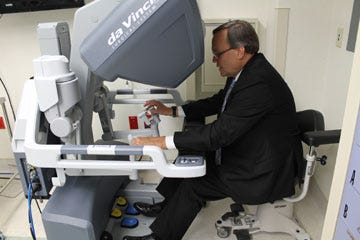
According to Baptist Health Care (BHC), the hospital is the first in the region to offer a weight-loss surgery known as a sleeve gastrectomy by way of the da Vinci S HD Surgical System.
BHC described the surgery saying the robotic sleeve gastrectomy is performed through five small keyhole incisions; the majority of the stomach is removed, leaving a narrow tube. As with gastric bypass, the smaller, sleeve-shaped stomach that remains is sealed, significantly reducing the amount of food the patient can eat while still allowing the stomach to function normally.
According to BHC, patients experienced decreased pain, fewer complications, a shorter hospital stay, and other benefits. Doctor Gatmaitan, who performs the robotic surgery said, "There is less torque encountered along the abdominal wall which can potentially account for the less pain post-operatively. The enhanced visualization and the articulating instruments help facilitate precise surgery which can contribute to decreased complications."
Gatmaitan said, "One of the major advantages of the robotic system is I can move the instruments in all directions, as if my hands were inside the abdominal cavity." Gatmaitan said, "With the da Vinci robot, the surgeon is able to view a magnified, high-resolution 3-D image of the surgical site inside the body."
Gatmaitan said he received his da Vinci certification in 2012 after a five-year general surgery residency at Conemaugh Memorial Medical Center in Pennsylvania where he became board certified, and then fellowship training in advanced laparoscopic and bariatric surgery at Cleveland Clinic from 2007 to 2009.
Gatmaitan said BHC follows the National Institutes of Health guidelines for eligibility for the surgery. He said, "The required body mass index (weight in kilograms divided by the square of the height in meters) is 40, or 35 or more if with significant medical conditions such as poorly controlled diabetes. He also said, "The patient is required to make several lifestyle changes. They need to make healthy food choices. They should eat small food portions at a time. They need to increase their activity and exercise regularly. They also need to take some vitamin and mineral supplementation."
According to BHC, The Baptist Bariatric Surgery Program has been recognized as a Center of Excellence® (BSCOE) by the American Society for Metabolic and Bariatric Surgery (ASMBS) and awarded the Gold Seal of Approval® by the Joint Commission on Accreditation of Healthcare Organizations.
Affiliated with both BHC and Santa Rosa Medical Center (SRMC) is Urogynecologist and Pelvic Reconstruction Surgeon Michael Coyle. SRMC Chief Executive Officer Philip Wright said Coyle uses SRMC's da Vinci robot for his pelvic reconstruction and urogynecological surgeries. Wright also said Pam Shurman, general surgeon, performs gall bladder and colon surgeries, and two other obstetric and gynecology surgeons, Mike Barber and Sue George, are trained in operating the surgical robot as well. Wright said surgeons don't tell the robot what to do, but physically manipulate the controls to perform a surgery. Wright demonstrated how the surgeon approaches the machine, sitting in its seat with foot-accessible buttons and two hand controls designed to manipulate the four wristed arms of the da Vinci. He also said the surgeon's three-dimensional view creates a sense of depth a normal monitor would not allow. Wright also pointed out the sensors near the display designed to shut the machine down if the surgeon's head moves back far enough.
According to Wright, SRMC's $1.7 million machine has simulator capabilities. He said physicians come to SRMC for training in the same way pilots train in simulators recreating effects of weather and other situations pilots eventually face in reality.
For more information about robotic sleeve gastrectomy, or to attend a free seminar at BHC, call 437-TRIM (8746) or visit BaptistHealthCare.org/Bariatrics
For more information on SRMC, call 626-7762 and for a look at how SRMC uses the da Vinci, visit http://www.srmcfl.com/medical-services/robotic-surgery-center
This article originally appeared on Santa Rosa Press Gazette: Robotics in medicine
